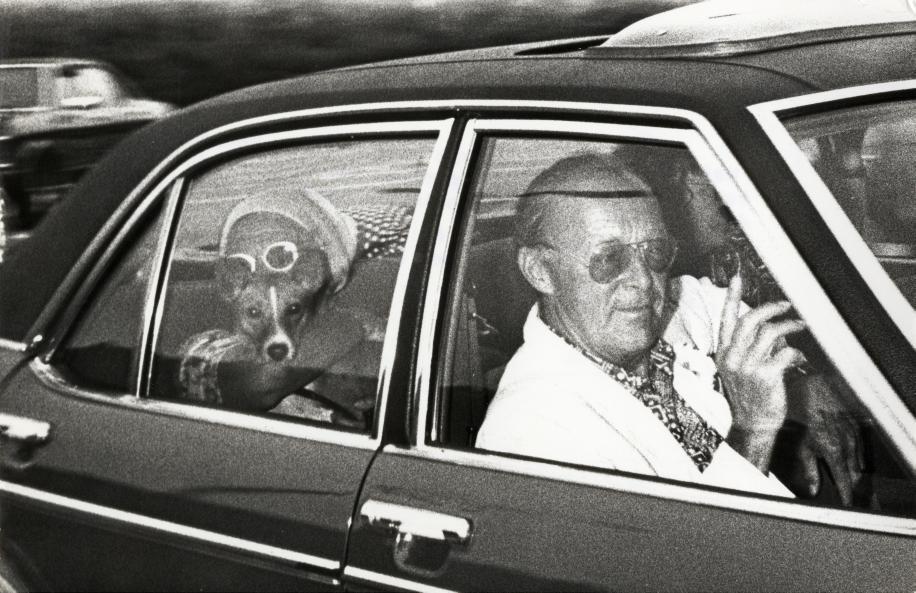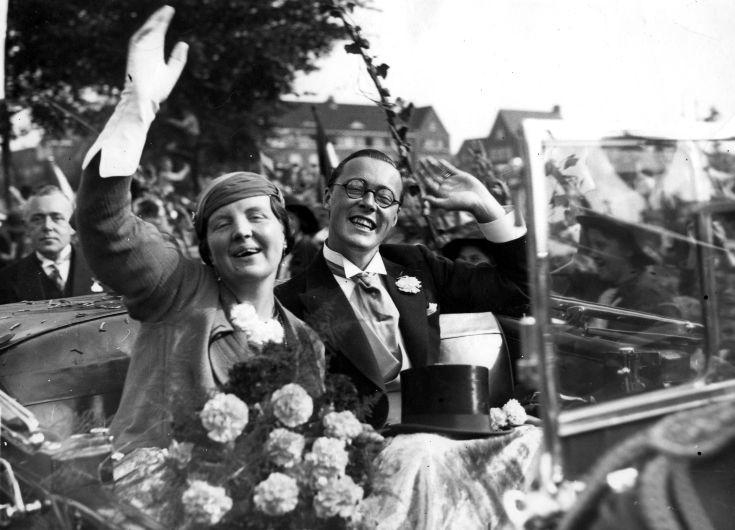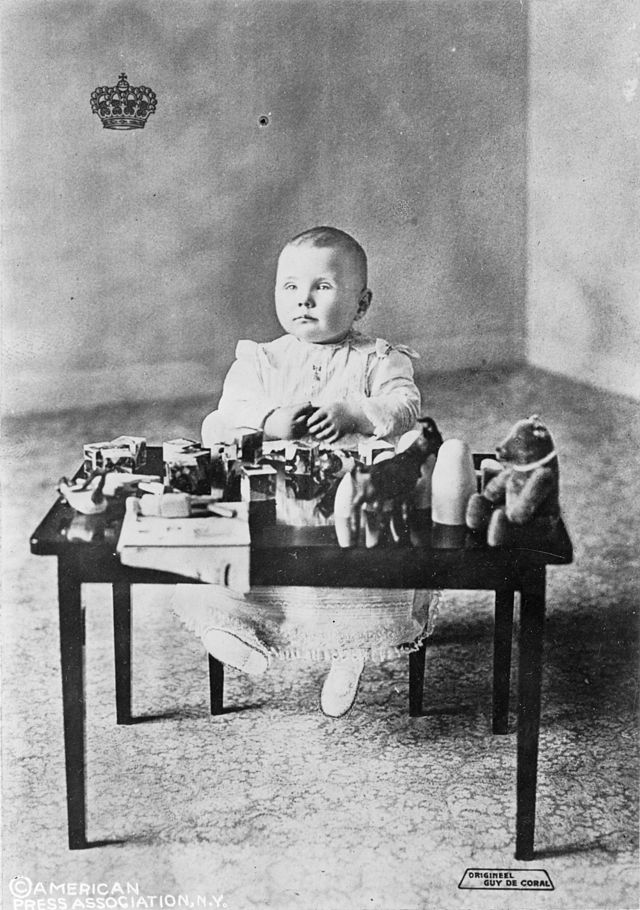by Susan Flantzer © Unofficial Royalty 2015

Queen Wilhelmina of the Netherlands; Credit – Wikipedia
Queen Wilhelmina holds the record for the longest-reigning Dutch monarch, 58 years. Her reign spanned World War I, the Great Depression, and World War II. Queen Wilhelmina’s father King Willem III was the third monarch of the Netherlands and had married his cousin Sophie of Württemberg in 1839. The couple had three sons, Willem (1840–1879), Maurits, (1843–1850), and Alexander (1851–1884), all predeceased their father without any legitimate children. Queen Sophie had died in 1877 and Willem was eager to remarry. After considering some other princesses, the 62-year-old Willem married Princess Emma of Waldeck and Pyrmont who was 21 years old. 19 months later, Willem and Emma’s only child Wilhelmina was born on August 31, 1880, at Noordeinde Palace in The Hague, Netherlands. At the time of her birth, Wilhelmina was third in the line of succession after her half-brother Alexander and her great-uncle Prince Frederick of the Netherlands. By the time Wilhelmina was four years old, both men had died and Wilhelmina was the heir presumptive.
Wilhelmina was named for:
- Wilhelmina: the feminine form of Willem, a traditional name of the House of Orange
- Helena: Helena of Waldeck and Pyrmont, sister of Queen Emma, who married Prince Leopold, Duke of Albany, Queen Victoria’s youngest son
- Pauline: Pauline of Waldeck and Pyrmont, sister of Queen Emma
- Marie: Marie of Waldeck and Pyrmont, sister of Queen Emma
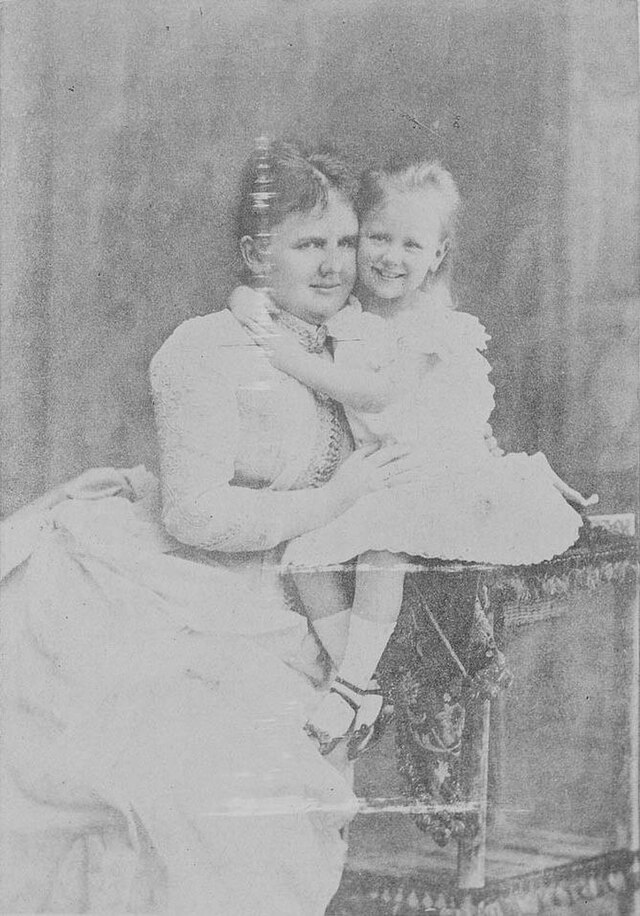
Wilhelmina with her mother; Credit – Wikipedia
King Willem III died on November 23, 1890, without producing a son with Queen Emma, so ten-year-old Wilhelmina became Queen of the Netherlands. Until Wilhelmina was 18 years old, Queen Emma served as regent. On September 6, 1898, when Wilhelmina was 18 years old, her inauguration was held at the Nieuwe Kerk in Amsterdam.

Inauguration of Queen Wilhelmina; Credit – Wikipedia
In May 1900, Queen Mother Emma and Queen Wilhelmina traveled to Schwarzburg-Rudolstadt in present-day Thuringia, Germany to meet with three marriage candidates: Prince Friedrich Wilhelm of Prussia (a great-grandson of King Willem I of the Netherlands) and two sons of Friedrich Franz II, Grand Duke of Mecklenburg-Schwerin. Only one of the Mecklenburg-Schwerin brothers showed up, Heinrich of Mecklenburg-Schwerin, and it was him that Emma and Wilhelmina selected. The engagement was announced on October 16, 1900. The wedding preparations were overshadowed by the deaths of Wilhelmina’s uncle Karl Alexander, Grand Duke of Saxe-Weimar-Eisenach on January 5, 1901, and Queen Victoria of the United Kingdom on January 22, 1901.
The couple was married on February 7, 1901, at the Grote of Sint-Jacobskerk in The Hague in the Netherlands. Following the wedding, Heinrich became a Prince of the Netherlands and was known by Hendrik, the Dutch version of his name. Wilhelmina decreed that the Dutch royal house would remain the House of Orange-Nassau and not change to the House of Mecklenburg-Schwerin. Although the marriage was a peaceful one, Wilhelmina and Hendrik grew apart due to her religious mysticism and his unfaithfulness and frustrations over his lack of an official role in the Netherlands.
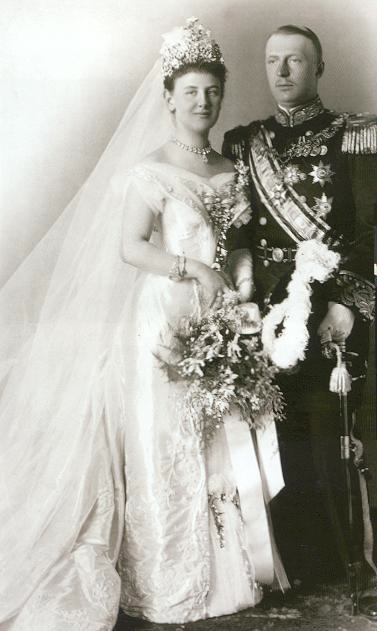
Wilhelmina and Hendrik on their wedding day; Credit – Wikipedia
Wilhelmina needed to provide herself with an heir or the Dutch throne would pass to her second cousin Wilhelm Ernst, Grand Duke of Saxe-Weimar-Eisenach, a grandson of Wilhelmina’s aunt Sophie. On November 9, 1901, Wilhelmina had her first miscarriage. In March 1902, it was announced that the Queen was pregnant again, but a month later Wilhelmina was seriously ill with typhoid fever. She miscarried again in May 1902 and her condition was life-threatening. Wilhelmina recovered and on July 23, 1906, she had a third miscarriage. At the end of 1908, an announcement was made that Wilhelmina was once again pregnant and her only child Juliana was born. After Juliana’s birth, Wilhelmina suffered two additional miscarriages in 1912.
- Queen Juliana of the Netherlands (1909 – 2004), married Prince Bernhard of Lippe-Biesterfeld, had four daughters including Queen Beatrix of the Netherlands

Wilhelmina with Juliana in 1914; Credit – Wikipedia
Wilhelmina had inherited a substantial amount of money from her father and her half-brother Alexander. She made wise investments that made her the world’s richest woman and the world’s first female billionaire (in United States dollars).
During World War I, the Netherlands remained neutral. While Queen Wilhelmina was concerned with the possibility of a German attack, the Allied blockade of Germany affected the Dutch. Dutch ships were included in the Allied blockade of Germany to ensure that none of the goods would get to the Germans. This severely restricted Dutch imports. At the end of World War I, Kaiser Wilhelm II fled to the Netherlands and was granted political asylum. When the Allied countries tried to gain custody of Wilhelm, Wilhelmina called the Allies’ ambassadors to a meeting and lectured them on the rights of political asylum.
During World War II, three days after Germany invaded the Netherlands in May 1940, the Dutch Royal Family left for London, England. One month later, Juliana and her daughters Beatrix and Irene went to Ottawa, Canada, where they would be safer. Juliana’s husband Prince Bernhard stayed with Queen Wilhelmina in London during the war, although both occasionally visited the family in Canada. Juliana’s third daughter Margriet was born while the family was in Canada. On August 2, 1945, the whole family returned to the Netherlands.

Queen Wilhelmina talks on the radio to the Dutch people during World War II; Credit – Wikipedia
After World War II, Juliana served twice as regent (October 14, 1947 – December 1, 1947, and May 14, 1948 – August 30, 1948) due to her mother’s ill health. On September 4, 1948, after a reign of nearly 58 years, Queen Wilhelmina abdicated in favor of her daughter and Juliana became Queen of the Netherlands. After her abdication, the former queen was styled Her Royal Highness Princess Wilhelmina of the Netherlands and retired to her home Het Loo Palace. She made few public appearances but did appear to support the Dutch people during the terrible floods of 1953.

The access to the royal crypt in the foreground; Credit – By Sander van der Wel from Netherlands – Royal grave tomb and the grave of Willem van Oranje, CC BY-SA 2.0, https://commons.wikimedia.org/w/index.php?curid=28146859
On November 22, 1962, the Dutch government announced that while there was no reason for immediate concern, Wilhelmina’s health had taken a turn for the worse. On November 28, 1962, Wilhelmina died at the age of 82 due to heart disease. After Wilhelmina’s death, it was announced that her condition during the last weeks of her life was more serious than had been announced. Wilhelmina was buried on December 8, 1962, in the royal crypt at the Nieuwe Kerk in Delft. According to her wishes, white dress was the protocol at her funeral.
This article is the intellectual property of Unofficial Royalty and is NOT TO BE COPIED, EDITED, OR POSTED IN ANY FORM ON ANOTHER WEBSITE under any circumstances. It is permissible to use a link that directs to Unofficial Royalty.
Kingdom of the Netherlands Resources at Unofficial Royalty


